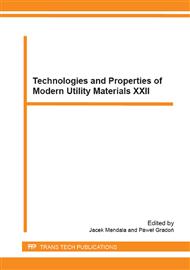p.155
p.161
p.167
p.173
p.177
p.185
p.189
p.193
p.199
A Study of Hot Corrosion Behaviour of NiAl Coatings in an Aggressive Environment
Abstract:
The microstructure and corrosion behaviour was studied for a diffusion β-NiAl and Si modified β-NiAl coatings formed on the superalloy MAR-M 247. First type, β-NiAl coating was applied with the help of method “out-of-pack”. Second type, Si modified β-NiAl coating was applied by method “pack-cementation”. Diffusion coatings created protective, heat-activated layer which separated superalloy from aggressive environment. Corrosive environment was created by tablets Na2SO4 at 900°C. Technique of scanning electron microscopy/energy dispersive X-ray analysis (SEM/EDS) was used to characterize the corrosion products. Experiment confirmed the advantages relating to the application of diffusion coating in aggressive environment which imitated environmental condition during operation of turbine engine. This experiment was made in cooperation with company PBS Velká Bíteš a. s., Velká Bíteš, Czech Republic and The Silesian University of Technology, Faculty of Materials Science and Metallurgy, Katowice, Poland.
Info:
Periodical:
Pages:
177-182
Citation:
Online since:
January 2015
Authors:
Price:
Сopyright:
© 2015 Trans Tech Publications Ltd. All Rights Reserved
Share:
Citation:


